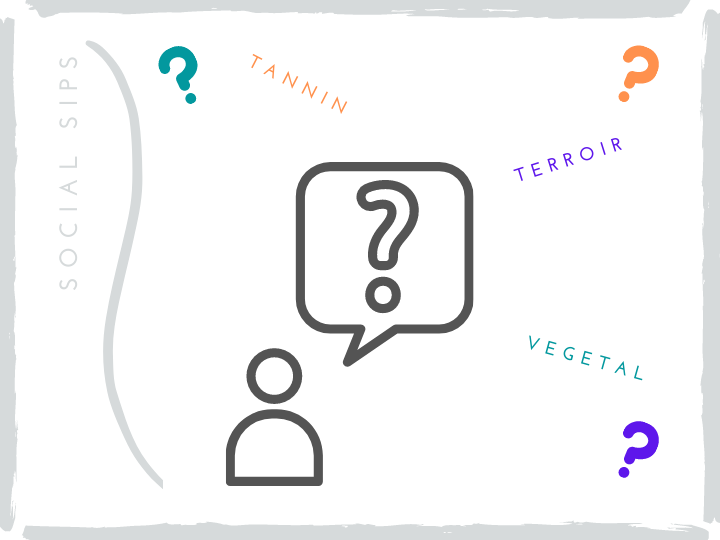Reading about wine or attending a wine tasting can sometimes feel like visiting a foreign country, grappling to understand a different language. I try to avoid too much ostentatious wine speak on my blog. My goal isn’t to show off by using flamboyant adjectives. I want you to stick around, don’t I? But some words are unavoidable. From winemaking terminology to flavour descriptors, it can feel like you’re drowning in chatter with words that don’t even exist in an English dictionary. It’s time to crack a bottle, pour a glass and break down 10 of the most confusing wine terms.
Acidity – Tart – Crunchy
All wines have acidity, but not all wines taste like it. Thankfully, other elements such as alcohol and sugar help balance a wine. Acidity is easier to detect in white wines, often because of citrus flavours that in varietals such as Sauvignon Blanc or Riesling. Because of this, tart can sometimes describe acidity. Y’ know, that mouth-watering or even puckering sensation. Crunchy is also a term that’s making appearances to describe both red and white wines with pronounced acidity.
To identify a wine with medium to high acidity, think about where in the mouth the flavours are most intense. If you experience a heightened sense, or brightness on the sides or roof of the mouth, the wine likely has higher acidity.
Bouquet – Nose – Aromas
These are all fancy words to describe the smell. And it’s important to remember that smelling your wine before taking a sip is a vital step in tasting wine. Not just because professionals do it, but it prepares your brain for what you’re about to taste.
There is one caveat when it comes to using any of these three words in place of one another. Traditionally, the term bouquet describes secondary aromas only, otherwise known as the notes which develop post-fermentation. So, while fruity and floral characteristics are primary aromas, secondary ones that come from oak or bottle aging (i.e. leather, coffee, nutty etc.)
Cuvée
Cuvée is a particular blend or batch of wine. For the most part, it’s used somewhat arbitrarily by winemakers as there isn’t any universal regulation on the term. There is one exception, however (isn’t there always?). In Champagne, cuvée refers to the juice from the first gentle pressing of the grapes.
Hot
This term has absolutely zero to do with a wine’s temperature. A hot wine refers to high alcohol levels. Often detectable in the aromas (it’ll irritate your nostrils) and most definitely noticeable with a burning sensation on the palate. Wines above 13.5 percent are high-alcohol while anything more than 15 percent is easily detectable.
Minerality
Minerality is one of those confusing wine terms that even the most versed wine enthusiasts have a difficult time defining. Everyone’s palate is different and interprets minerality in their own way. I find it easiest to remind myself that minerals are in the ground. There are many vineyards around the world with stoney or gravely soil and that can sometimes equate to slate or flint-like notes. When it comes down to it, there are no traces of these minerals in the wine.
Quaffable
The dictionary defines quaff as a verb for an alcoholic drink that you can drink heartily. Quaffable takes the term one step further and can be used interchangeably with crushable, poundable or slammable.
(Side note: always drink responsibly)
Tannins
We hear about tannins often, but few people can identify what it is and what causes them. Tannins are the drying sensation in your mouth (very much the opposite of those mouth-watering acids we mentioned earlier) and are derived from the skins of the grape. This is why we often call red wines tannic and not white wines – because white wines don’t stay in contact with their skins during any the winemaking process, while red wines do.
Tannins add both structure and balance to wine and evolve the complexities through aging.
Terroir
Terroir describes a specific microclimate, or ‘sense of place’ as the winos call it these days. Essentially, terroir is a vineyard’s environment. From climate (hot or cold) to soil type. Or elevation to an area’s local plant life. Anything that can impact how the grapes grow, and in turn how the wine tastes, is terroir.
Tight
A tight wine has immense structure and intensity (and is perhaps meant to age for a long time) and has been opened before its intended prime drinking window. Decanting is often the solution. With aeration, the aroma and flavour molecules breathe and release some of its true and intended character.
Vegetal – Herbaceous
A generalization of a vegetal or herbaceous wine is one that is savoury or earthy. While most younger wines lean pretty heavily into fruit and floral descriptors, some varieties have a slightly vegetal, or green quality – like Sauvignon Blanc or Cabernet Sauvignon. For the most part, these qualities are a good thing and add dimension to the flavour profile. However, if you come across too much of this in a wine that isn’t supposed to have it, then it’s considered a flaw.
I hope this has shed some light on some of the many confusing wine terms used in the industry. If you’re looking to expand your vocabulary when it comes to wine descriptors, take a look at my Wine Flavour Chart available on my Etsy shop.

